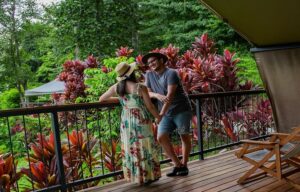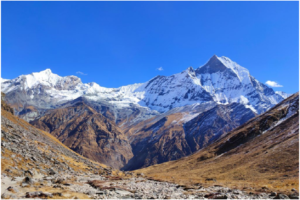Annapurna Circuit and Mardi Himal: Trekking Nepal’s Finest:

Nepal’s Annapurna locale offers a few of the most famous trekking encounters in the world, combining normal magnificence, social abundance, and changing levels of challenge. Among the most celebrated treks in this locale are the Annapurna Circuit Trekking, the Ghorepani Poon hill trek, and the Mardi Himal Trekking. These courses grandstand the differing qualities of Nepal’s scenes, from subtropical timberlands to snow-capped glades and towering crests. This directly plunges profoundly into each trek, making a difference in how you arrange the experience of a lifetime.\
Annapurna Circuit Trekking: The Classic Himalayan trek
Overview and Highlights
The Annapurna Circuit trek is one of the most famous trekking courses in the world. Traversing 160-230 kilometers (depending on the course varieties), it circles the Annapurna Massif and offers trekkers a differing cluster of scenes, from terraced areas and thick woodlands to high-altitude deserts. The highlight of the trek is crossing the Thorong La Pass at 5,416 meters, one of the most elevated trekking passes in the world.
Key Attractions
Thorong La Pass: The extreme challenge and compensation of the trek, with breathtaking views of the Annapurna and Dhaulagiri ranges.
Manang: A beautiful high-altitude town advertising acclimatization and social exploration.
Muktinath Sanctuary: A sacrosanct trek location for Hindus and Buddhists, settled in the Bronco region.
Diverse Scenes: Involvement in everything from lavish subtropical woodlands to parched Tibetan plateaus.
Trek Details
Duration: 15-20 days, depending on your pace and acclimatization needs.
Difficulty: Direct to challenging, requiring great physical wellness and preparation.
Best Season: Spring (March-May) and Harvest time (September-November).
Ghorepani Poon hill trek: A Brief but Fulfilling Adventure
Why Select This Trek?
The Ghorepani Poon Hill trek is a culmination for those looking for a brief, however marvelous, trekking involvement. Known for its dawn view from Poon Hill, this trek offers a display of a few of the most elevated crests in the world, counting Annapurna South, Dhaulagiri, and Machapuchare (Fishtail).
Key Highlights
Poon Hill Perspective: The trek’s highlight, advertising a staggering dawn over the Annapurna and Dhaulagiri ranges.
Traditional Towns: Investigate Gurung and Magar towns, encountering their warm neighborliness and interesting culture.
Rhododendron Woodlands: Amid spring, the trails are embellished with blooming rhododendrons, making an enchanted atmosphere.
Trek Details
Duration: 4-6 days, making it perfect for those with constrained time.
Difficulty: Simple to direct, appropriate for fledglings and families.
Best Season: Spring and harvest time for clear skies and ideal climate conditions.
Mardi Himal Trekking: A Covered-Up Pearl in Annapurna
Introduction to Mardi Himal
Tucked away in the shadows of the Annapurna run, the Mardi Himal trek is a moderately modern path that offers isolation and untainted excellence. The trek leads you to Mardi Himal Base Camp at 4,500 meters, giving dazzling views of Machapuchare, Annapurna South, and Hiunchuli.
Why trek Mardi Himal?
Off-the-Beaten-Path: Maintain a strategic distance from the swarms of more prevalent trails and appreciate a quiet trekking experience.
Panoramic Sees: The trek offers close-up views of the Annapurna extend, especially the notorious Machapuchare.
Diverse Scenes: From rich timberlands to rough high-altitude landscapes, this trek has it all.
Trek Details
Duration: 5-7 days, making it an extraordinary choice for trekkers with restricted time.
Difficulty: Direct, with a few steep climbs and descents.
Best Season: Spring and harvest time, when the climate is steady and the skies are clear.
Choosing the Right Trek
Time Imperatives: If you have restricted time, the Ghorepani Poon hill or Mardi Himal treks are perfect. For a longer, more immersive encounter, the Annapurna Circuit is unparalleled.
Experience Level: Fledglings may discover the Ghorepani Poon hill trek more reasonably, whereas prepared trekkers looking for a challenge will appreciate the Annapurna Circuit or Mardi Himal Trek.
Permits and Regulations
Annapurna Preservation Zone Allow (ACAP): Required for all treks in the region.
TIMS Card (Trekkers’ Data Administration Framework): Essential for following and security purposes.
Packing Essentials
-
Sturdy trekking boots and warm layers for tall altitudes.
-
A great quality resting sack and trekking poles.
-
Sunscreen, shades, and a cap for sun protection.
-
Snacks and a refillable water bottle for hydration on the trails.
-
Cultural and Characteristic Ponders Along the Way
Local Communities

The Annapurna Region is home to different ethnic groups, including Gurungs, Magars, and Thakalis. Trekkers can submerge themselves in nearby conventions, visit religious communities, and appreciate bona fide Nepali cooking like dal bhat.
Flora and Fauna
The trails navigate wealthy biological systems, from subtropical timberlands abounding with birdlife to snow-capped knolls. Rhododendrons, Nepal’s national blossom, are a common sight amid spring.
Scenic Highlights
Machapuchare (Fishtail): A sacrosanct top that rules the horizon on the Mardi Himal and Ghorepani treks.
Annapurna Massif: Towering crests like Annapurna I (8,091 m), the 10th most noteworthy mountain in the world.
Sunrise and Dusk See: Involvement in awe-inspiring minutes as the sun enlightens the Himalayan giants.
Tips for an Important Trekking Experience
Acclimatize Appropriately: To maintain a strategic distance from high-altitude affliction, take rest days and climb continuously, particularly on the Annapurna Circuit.
Hire a director or watchman: They can give important nearby information and diminish your stack, permitting you to appreciate the trek fully.
Respect the Environment: Take after the standards of Take off No Follow, counting arranging of squander capably and maintaining a strategic distance from single-use plastics.
Stay Hydrated: Drink a bounty of water to remain energized and combat the impacts of high altitude.
Embrace the Travel: Trekking in Nepal is as much about the social encounter as it is about the physical challenge. Take time to connect with local people and douse yourself in the scenery.
Altitude Sickness
Causes of Altitude Sickness
Altitude sickness occurs when ascending rapidly to high altitudes, reducing oxygen levels in the air. Factors include climbing too quickly, lack of acclimatization, dehydration, or individual susceptibility.
Prevention
Ascend gradually, allowing for proper acclimatization. Stay hydrated, eat light meals, avoid alcohol, and get adequate rest. Using equipment like trekking poles eases the strain on your body.
Equipment
Essential gear includes trekking poles, insulated clothing, a quality sleeping bag, hydration packs, and an oximeter to monitor oxygen levels.
Dealing with Symptoms
Mild symptoms like headaches and nausea can improve with rest and hydration. If symptoms worsen (e.g., confusion or breathlessness), descend immediately.
First Aid
Carry essential items: a pulse oximeter, Diamox, and an oxygen canister. A Gamow bag may be useful for emergencies in remote areas.
Equipment
Clothing
-
Layered Clothing: Base layers, fleece jackets, and waterproof outer layers are crucial to adapt to fluctuating temperatures, especially at higher altitudes.
-
Insulated Jacket: Necessary for cold mornings and evenings at higher elevations.
-
Trekking Pants: Lightweight and quick-drying pants are ideal for daytime, paired with thermal pants for colder nights.
-
Hats and Buffs: A warm hat for the cold and a buff or scarf to protect against wind and dust.
-
Gloves: Thermal gloves for warmth and lightweight gloves for general use.
Footwear
-
Trekking Boots: Sturdy, waterproof, and well-broken-in boots are essential for navigating uneven trails.
-
Trekking Socks: Woolen socks to keep your feet warm and blister-free.
Gear and Accessories
-
Backpack (30-40L): To carry daily essentials like snacks, water, and extra clothing.
-
Sleeping Bag (rated -10°C): Nights can get chilly, especially in higher-altitude teahouses.
-
Trekking Poles: Help reduce strain on knees during ascents and descents.
-
Headlamp: For early morning starts or low-light conditions.
-
Water Bottles and Purification Tablets: To stay hydrated, clean water may not always be available.
-
First Aid Kit: Include basic medicines, blister care, and altitude sickness medication.
Other Essentials
-
Sunglasses and Sunscreen: Protection against strong UV rays at high altitudes.
-
Snacks and Energy Bars: For quick energy during long trekking days.
-
Rain Cover: To protect your gear during unexpected rain showers.
Conclusion: Nepal’s Finest Treks Await
Whether you’re captivated by the greatness of the Annapurna Circuit, the charm of the Ghorepani Poon hill trek, or the isolation of the Mardi Himal path, the Annapurna locale offers something for each trekking devotee. Each course presents a special mix of characteristic excellence, social inundation, and individual challenge. Plan well, select the trek that suits your objectives and encounter level, and set out on a trip that will take you with recollections to final a lifetime.
Contact Us Team Himalaya For More Info
Team Himalaya Pvt. Ltd. is a trusted local trekking company based in Kathmandu, Nepal. We specialize in organizing multi-day tours, treks, climbing adventures, expeditions, and other related activities for solo travelers and private groups. Our services extend across Nepal, Bhutan, and Tibet.
For inquiries,
feel free to reach out to us at [email protected] or via Whats App at +9779841824281.






